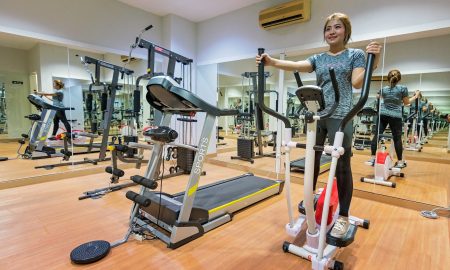
Can I Work Out With a Torn Bicep Tendon?

Can you work out with a torn bicep tendon? This is a common question for those dealing with this painful injury. While a torn bicep tendon can significantly impact your ability to exercise, understanding the injury and how to manage it can help you make informed decisions.
What Is a Torn Bicep Tendon?
A bicep tendon connects your bicep muscle to your shoulder and elbow. When this tendon tears, it can either partially or completely detach from the bone. This injury often results from heavy lifting, repetitive strain, or sudden trauma. The tear can occur at the shoulder (proximal) or the elbow (distal), with symptoms ranging from pain and swelling to noticeable muscle deformity.

Andrea Piacquadio | Pexels | A torn bicep tendon often results from heavy lifting, repetitive strain, or sudden trauma.
Signs and Symptoms of a Torn Bicep Tendon
Recognizing the signs of a torn bicep tendon is crucial. Symptoms include a sudden ‘pop’ in the upper arm, bruising, swelling, and a visible bulge in the muscle. Pain and weakness when using the affected arm are also common. If these symptoms occur, seeking medical attention promptly is essential to prevent further damage and determine the best treatment course.
Can I Work Out With a Torn Bicep Tendon?
Continuing to exercise with a torn bicep tendon is possible, but it requires caution. Certain exercises can help maintain your fitness level without worsening the injury. However, it’s vital to avoid movements that strain the injured tendon. Safe exercises include:
- Biceps Stretch: The biceps stretch is a gentle exercise that helps maintain flexibility without placing undue strain on the tendon. Perform this stretch three times daily, holding each stretch for 15-30 seconds.
- Elbow Flexion and Extension: Elbow flexion and extension exercises help maintain arm strength and flexibility. These exercises should be performed 15 times for two sets, twice daily.
- Shoulder Flexion: Shoulder flexion involves raising the injured arm forward and overhead to improve shoulder mobility and activate the bicep. Perform this exercise eight to 12 times, two times daily.
- Isometric Bicep Contractions: Isometric bicep contractions are safe exercises that activate the bicep without excessive strain. These exercises help maintain muscle engagement during recovery.

Miriam Alonso | Pexels | Biceps stretch is a gentle exercise that helps maintain flexibility without placing undue strain on the tendon.
Exercises to Avoid
While staying active is essential, avoiding exercises that could exacerbate the injury is equally crucial. Lifting heavy weights, particularly those that engage the bicep directly, should be avoided. Exercises that you should avoid include:
- Heavy Lifting Exercises: Lifting heavy weights, particularly those that engage the bicep directly, should be avoided. Exercises like deadlifts and power cleans put too much strain on the injured tendon.
- Direct Arm Work: Avoid exercises like bicep curls and tricep pushdowns, as they directly target the bicep and increase the risk of further injury.
- Overhead Lifting: Exercises that require overhead lifting, such as shoulder presses, should be avoided to prevent additional strain on the tendon.
- Bodyweight Exercises: Certain bodyweight exercises, including pull-ups and chin-ups, can place significant stress on the injured bicep and should be avoided during recovery.
Rehabilitation and Recovery
The recovery process for a torn bicep tendon often involves a combination of rest, physical therapy, and in some cases, surgery. Physical therapy plays a key role in regaining strength and mobility. Exercises are designed to protect the tendon while promoting healing. In severe cases, surgical intervention may be necessary to reattach the tendon to the bone, followed by an extended rehabilitation period.
Preventing Future Bicep Tendon Injuries
Preventing future bicep tendon injuries involves strengthening the surrounding muscles and practicing proper exercise techniques. Incorporating exercises focusing on shoulder stability and avoiding repetitive strain on the bicep are vital strategies. Warm-up routines and gradual progression in weight lifting can also help protect the tendon from injury.
More in Health & Fitness
-
`
How to Plan a Trip to Italy and Greece
Italy and Greece stand out as two of Europe’s premier travel destinations, each offering a unique blend of historical grandeur, stunning...
July 31, 2024 -
`
Are Makeup Wipes Bad for Your Skin?
In the quest for quick and convenient skincare, makeup wipes often seem like a miracle solution. However, if you’re wondering, Are...
July 26, 2024 -
`
How to Do Ab Workouts During Pregnancy?
Maintaining core strength is vital, but can you do ab workouts while pregnant? This question is common among expectant mothers eager...
July 19, 2024 -
`
5 Seamless Ways to Minimize BBL Scars
Undergoing a Brazilian Butt Lift (BBL) is an exciting decision for enhancing your body contour. However, BBL scars can be a...
July 12, 2024 -
`
Best Places for Birthday Party Fun for All Ages
Celebrating your birthday at an exciting venue can add that extra spark to your special day, whether you’re with family, friends,...
July 2, 2024 -
`
Skincare for Sensitive Skin: Top 6 Products to Try
Taking care of sensitive skin can be a challenge. With so many products on the market, finding the right ones that...
June 28, 2024 -
`
How to Build Muscles & Gain Mass After 50
Are you wondering how to build muscle mass after 50? You are not alone. Many people think that hitting the big...
June 20, 2024 -
`
How to Speed Up Your Nose Job Recovery Time
Undergoing a rhinoplasty is an exciting step towards a new appearance, but it comes with a recovery period that requires patience...
June 15, 2024 -
`
Best Tattoo Ideas for Women With Meaning
Are you on the hunt for tattoo ideas for women with meaning? Tattoos are more than just body art; they’re personal...
June 4, 2024















You must be logged in to post a comment Login